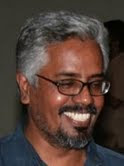ADAYALANGAL BY M G SASI
Marking a Writer and His Times
M G Sasi's Adayalangal which won several State Awards including that for the Best Film and Direction, is an honest attempt to look into the formative years of an intense writer like Nandanar. It is a tribute to a great writer whose life was torn between great lust for life on the one and luring temptations of self-destruction on the other, to the latter of which he yielded in the end. In the process the film brings to life a disturbing period – the depressing 1960's – of Kerala society; times that were bleak and miserable with war and poverty looming large in the horizon.
The story unfolds in a typical central Kerala village with scanty resources to go around and where everyone is cash-poor. In this economy that is totally cut off yet prey to a war that is happening in the outside world, everyone ekes out a living, doing odd jobs and with no hopes about the future. Sasi weaves together various characters from Nandanar's story world into this coming-of-age narrative of despairing adolescence. There is a depressing and fatal sense of claustrophobia to that remote village, where there life is at a standstill as is its economy. Everything is stagnant and regressive. Ironically, the only way to get out of this trap is the very mechanism – war - that contributed to this situation in the first place. Eventually, the adolescent protagonist Gopinathan (an impressive debut by Govind Padmasurya) has to join the army to escape that petty, narrow world.
The life of this youth is confined to the limits of the village. His only medium to understand and experience the world is the people around him. They virtually make their entry and exit into his stagnant world. It is also picturised thus, with these characters entering and exiting, or him going to them or stumbling upon them: among them are his father who is an artist with no work and is at a loss as to how to survive, the school master who takes him back to school, his uncle who is the only person concerned about him, the gay entrepreneur who offers him job in his beedi factory, his brother who has relinquishes his siblings to join the army, the traditional oracle from the lower caste who tries to help him, the junior poduval who sings to the horizon, the nambudiri landlord who is concerned only about himself etc. The female world comprises of his aunts and cousins – all poor and eking out a living out of nothing, with no hopes for exuberance of any kind; they go on bickering, cursing, and fighting. His only hope comes in the form of the teacher and Meenakshikutty, the girl who sparks erotic fantasies in him. They are the only ones who liberate him and enable him to get out of that cursed village. The film ends with his departure to the outside world to join the army. It is a move away from a closed world into the vast unknown.
Adayalangal is a quiet and probing kind of film that doesn't pretend to be anything else, and it has a kind of charming directness to it, which stands out in our films filled with idiotic sound and fury. Its simple yet rich and varied narrative format that throngs with short yet memorable appearances of several characters – some really good performances by Manikandan, TG Ravi etc – gives one a peep into Nandanar's world and times.
Labels: ADALAYALANGAL, malayalam cinema

